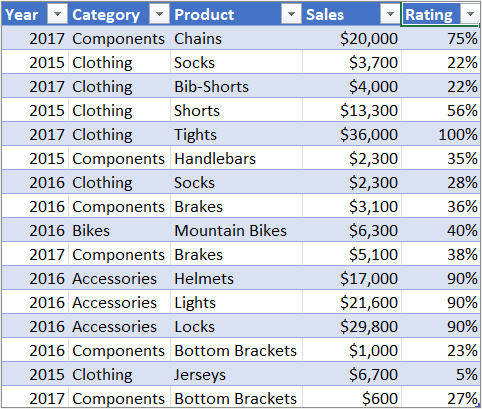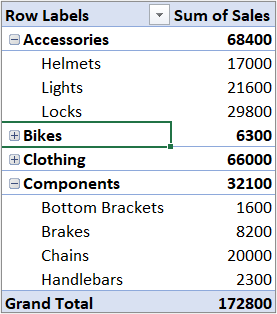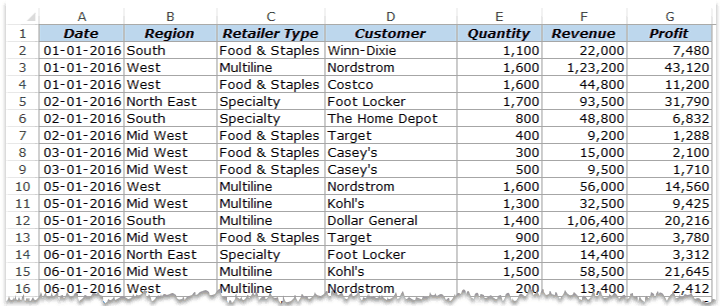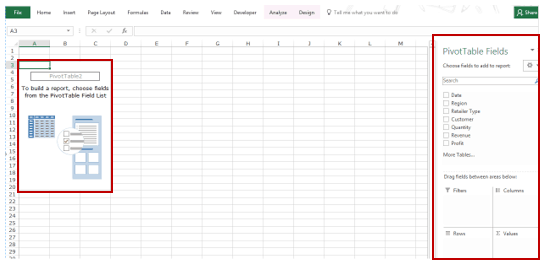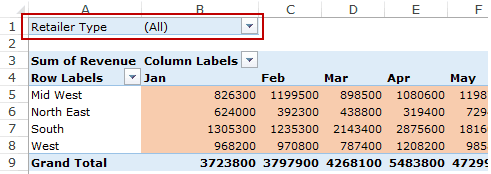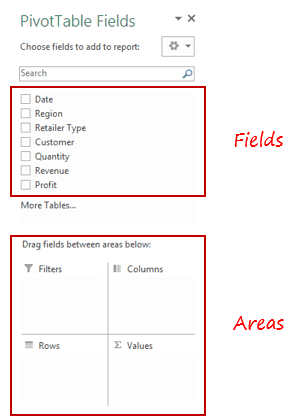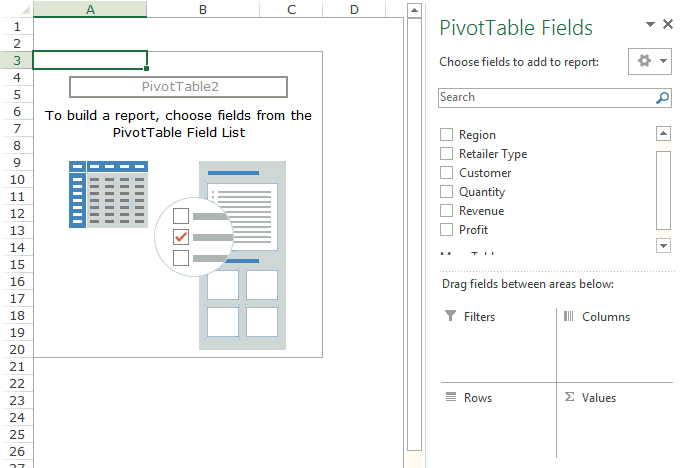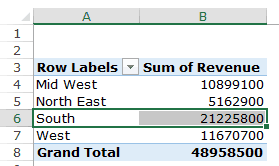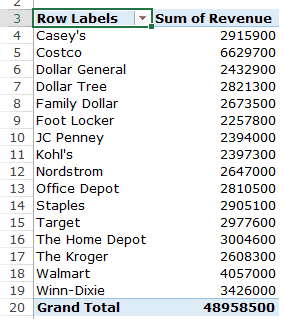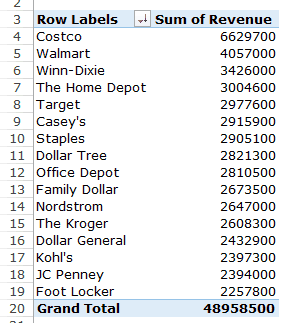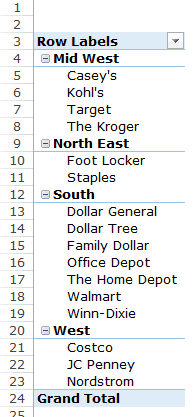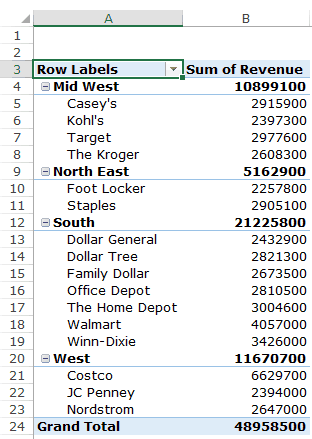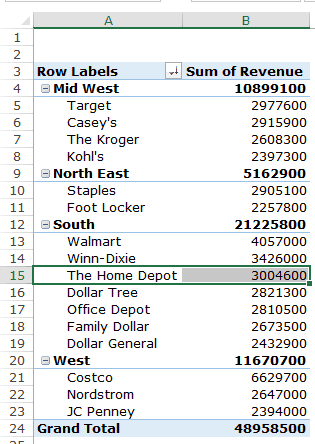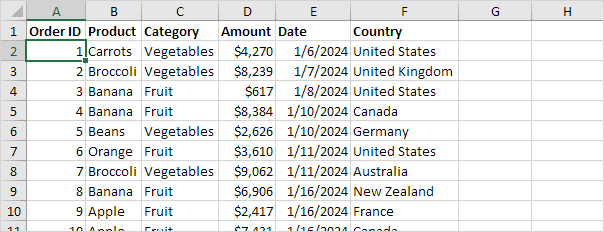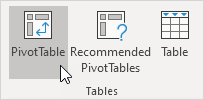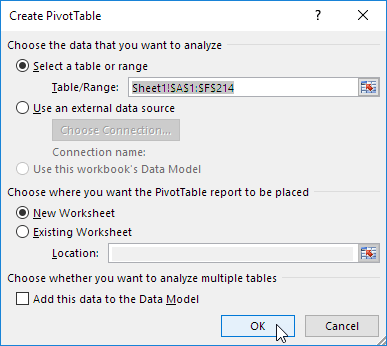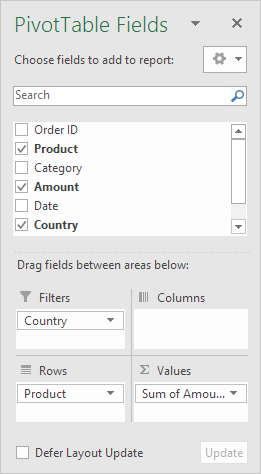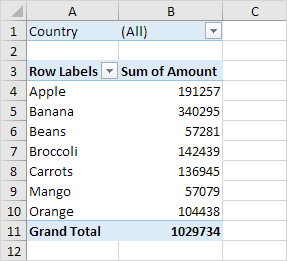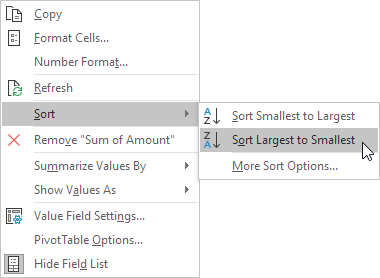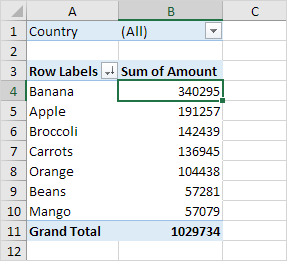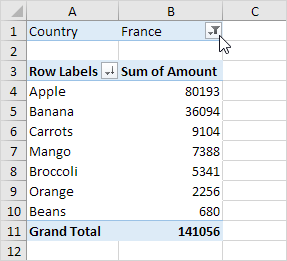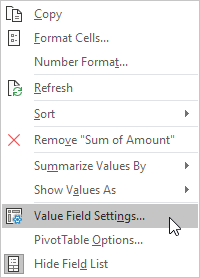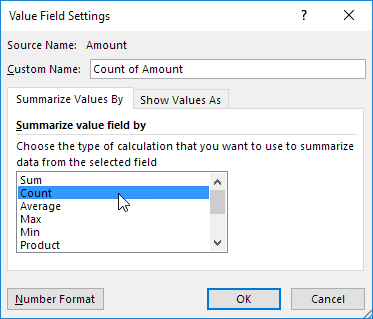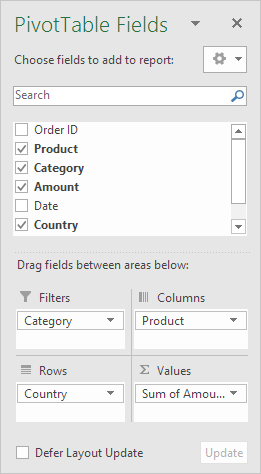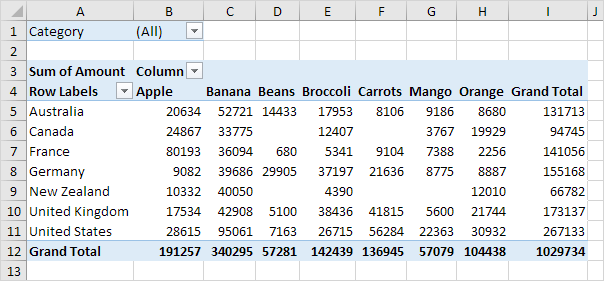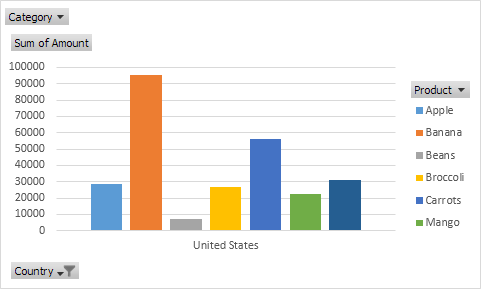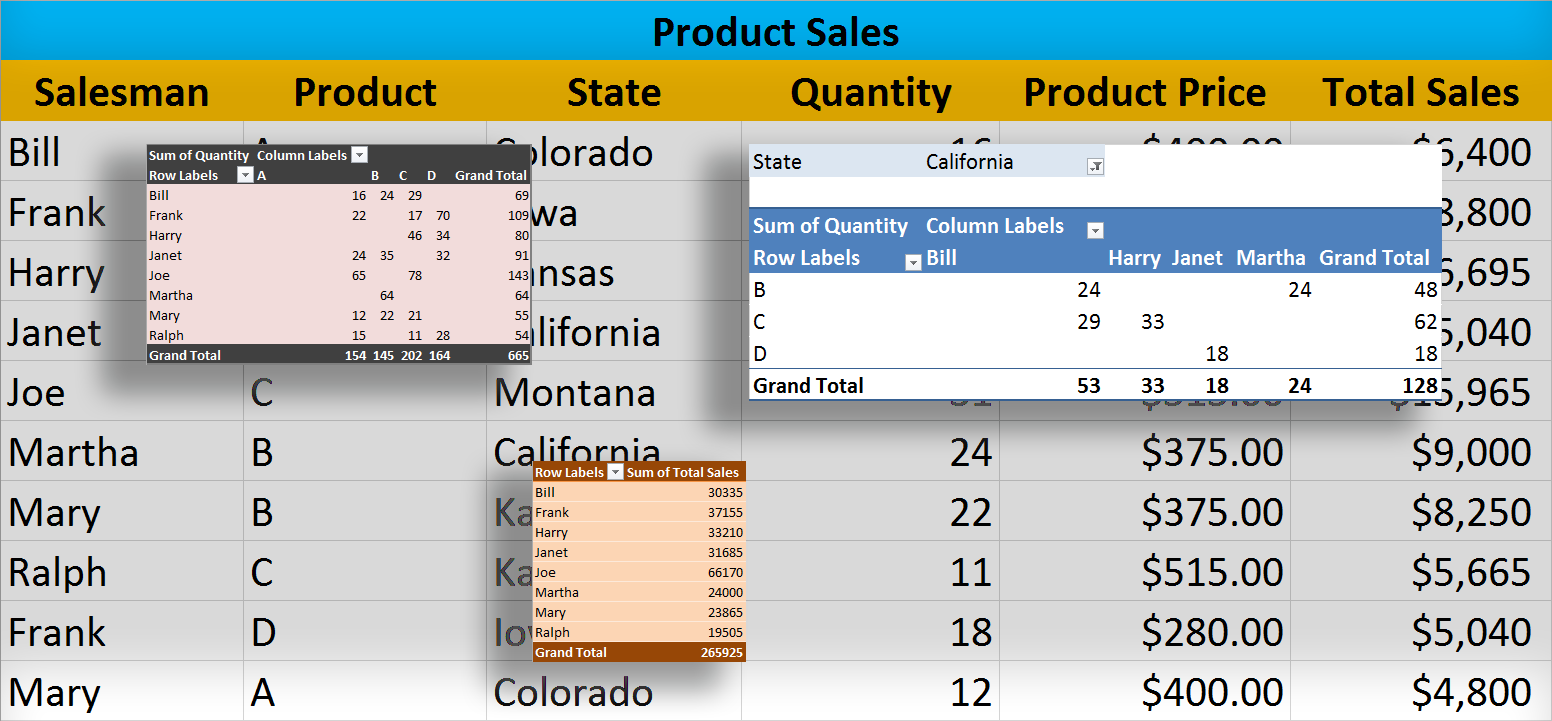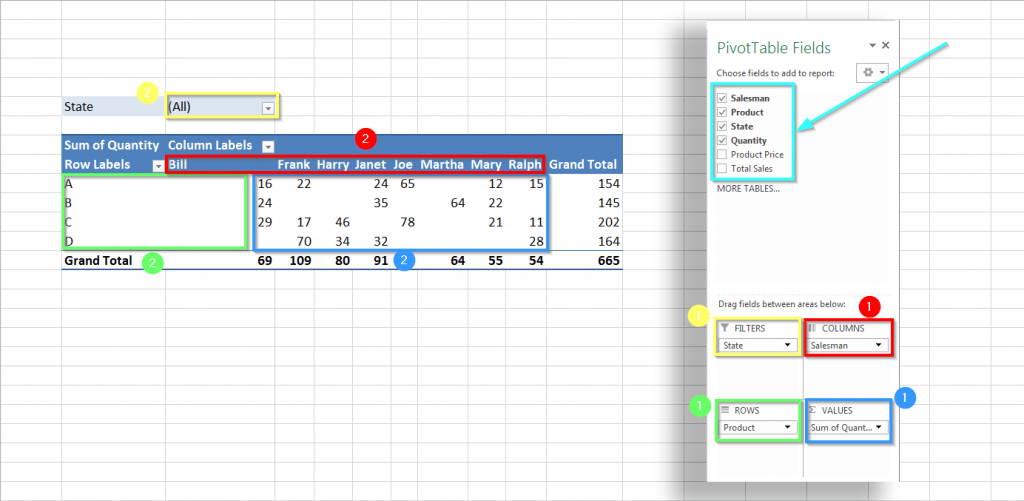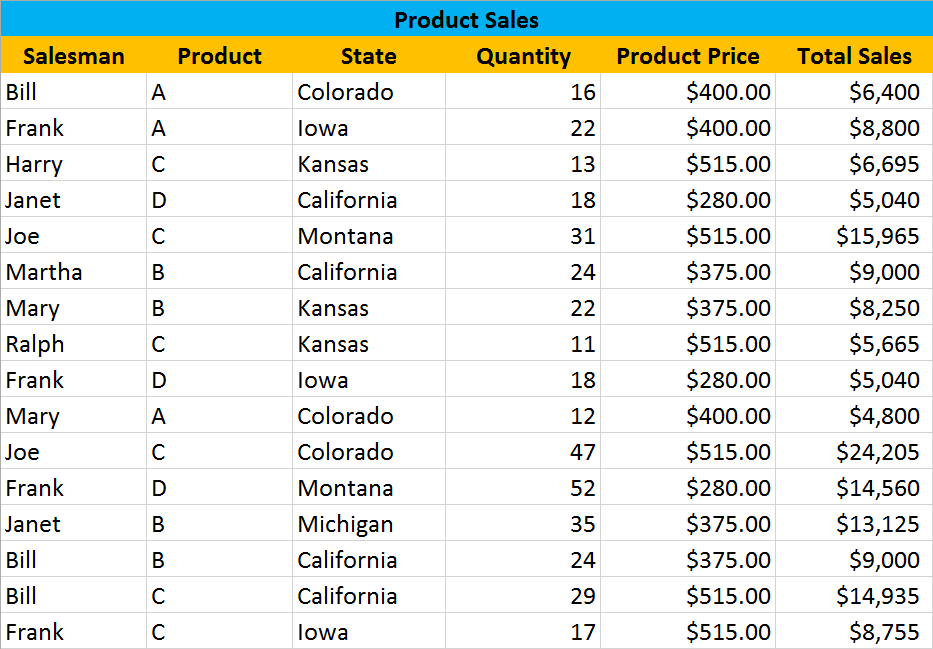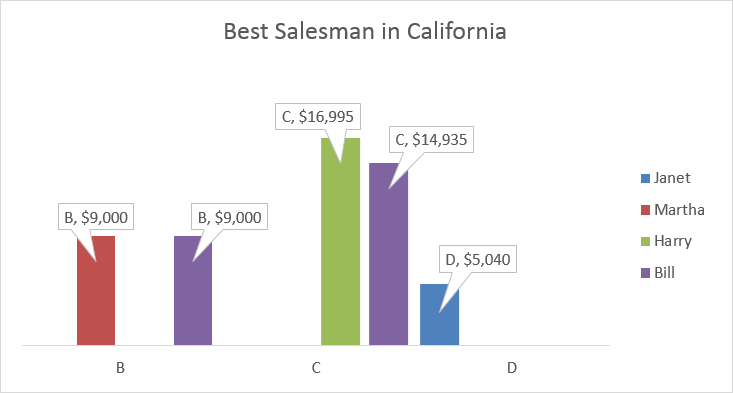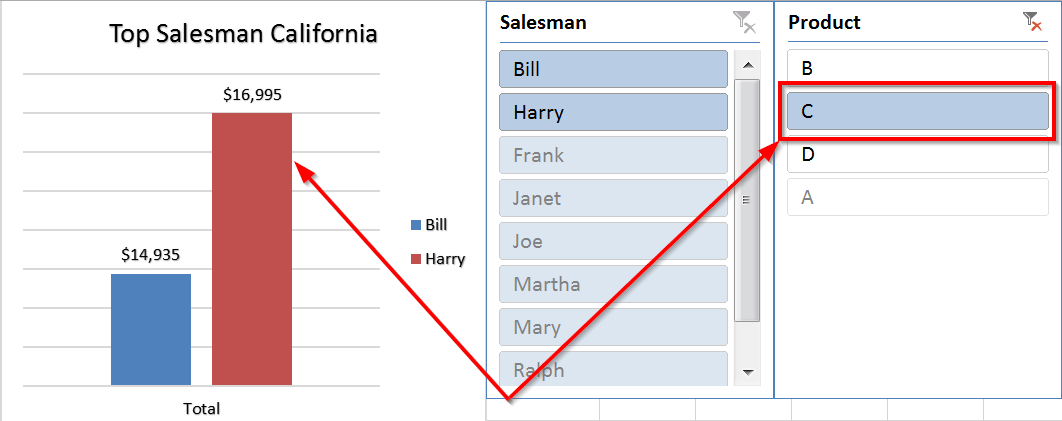Excel for Microsoft 365 Excel for Microsoft 365 for Mac Excel for the web Excel 2021 Excel 2019 Excel 2016 Excel 2013 Excel 2010 Excel 2007 More…Less
You can use a PivotTable to summarize, analyze, explore, and present summary data. PivotCharts complement PivotTables by adding visualizations to the summary data in a PivotTable, and allow you to easily see comparisons, patterns, and trends. Both PivotTables and PivotCharts enable you to make informed decisions about critical data in your enterprise. You can also connect to external data sources such as SQL Server tables, SQL Server Analysis Services cubes, Azure Marketplace, Office Data Connection (.odc) files, XML files, Access databases, and text files to create PivotTables, or use existing PivotTables to create new tables.
A PivotTable is an interactive way to quickly summarize large amounts of data. You can use a PivotTable to analyze numerical data in detail, and answer unanticipated questions about your data. A PivotTable is especially designed for:
-
Querying large amounts of data in many user-friendly ways.
-
Subtotaling and aggregating numeric data, summarizing data by categories and subcategories, and creating custom calculations and formulas.
-
Expanding and collapsing levels of data to focus your results, and drilling down to details from the summary data for areas of interest to you.
-
Moving rows to columns or columns to rows (or «pivoting») to see different summaries of the source data.
-
Filtering, sorting, grouping, and conditionally formatting the most useful and interesting subset of data enabling you to focus on just the information you want.
-
Presenting concise, attractive, and annotated online or printed reports.
For example, here’s a simple list of household expenses on the left, and a PivotTable based on the list to the right:
|
Sales data |
Corresponding PivotTable |
|
|
|
For more information, see Create a PivotTable to analyze worksheet data.
After you create a PivotTable by selecting its data source, arranging fields in the PivotTable Field List, and choosing an initial layout, you can perform the following tasks as you work with a PivotTable:
Explore the data by doing the following:
-
Expand and collapse data, and show the underlying details that pertain to the values.
-
Sort, filter, and group fields and items.
-
Change summary functions, and add custom calculations and formulas.
Change the form layout and field arrangement by doing the following:
-
Change the PivotTable form: Compact, Outline, or Tabular.
-
Add, rearrange, and remove fields.
-
Change the order of fields or items.
Change the layout of columns, rows, and subtotals by doing the following:
-
Turn column and row field headers on or off, or display or hide blank lines.
-
Display subtotals above or below their rows.
-
Adjust column widths on refresh.
-
Move a column field to the row area or a row field to the column area.
-
Merge or unmerge cells for outer row and column items.
Change the display of blanks and errors by doing the following:
-
Change how errors and empty cells are displayed.
-
Change how items and labels without data are shown.
-
Display or hide blank rows
Change the format by doing the following:
-
Manually and conditionally format cells and ranges.
-
Change the overall PivotTable format style.
-
Change the number format for fields.
-
Include OLAP Server formatting.
For more information, see Design the layout and format of a PivotTable.
PivotCharts provide graphical representations of the data in their associated PivotTables. PivotCharts are also interactive. When you create a PivotChart, the PivotChart Filter Pane appears. You can use this filter pane to sort and filter the PivotChart’s underlying data. Changes that you make to the layout and data in an associated PivotTable are immediately reflected in the layout and data in the PivotChart and vice versa.
PivotCharts display data series, categories, data markers, and axes just as standard charts do. You can also change the chart type and other options such as the titles, the legend placement, the data labels, the chart location, and so on.
Here’s a PivotChart based on the PivotTable example above.
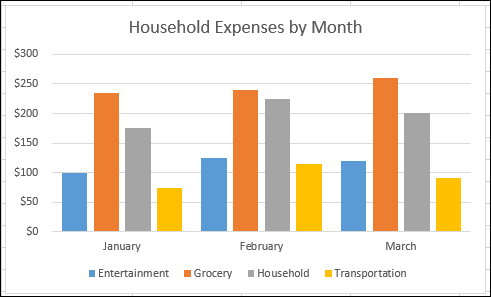
For more information, see Create a PivotChart.
If you are familiar with standard charts, you will find that most operations are the same in PivotCharts. However, there are some differences:
Row/Column orientation Unlike a standard chart, you cannot switch the row/column orientation of a PivotChart by using the Select Data Source dialog box. Instead, you can pivot the Row and Column labels of the associated PivotTable to achieve the same effect.
Chart types You can change a PivotChart to any chart type except an xy (scatter), stock, or bubble chart.
Source data Standard charts are linked directly to worksheet cells, while PivotCharts are based on their associated PivotTable’s data source. Unlike a standard chart, you cannot change the chart data range in a PivotChart’s Select Data Source dialog box.
Formatting Most formatting—including chart elements that you add, layout, and style—is preserved when you refresh a PivotChart. However, trendlines, data labels, error bars, and other changes to data sets are not preserved. Standard charts do not lose this formatting once it is applied.
Although you cannot directly resize the data labels in a PivotChart, you can increase the text font size to effectively resize the labels.
You can use data from a Excel worksheet as the basis for a PivotTable or PivotChart. The data should be in list format, with column labels in the first row, which Excel will use for Field Names. Each cell in subsequent rows should contain data appropriate to its column heading, and you shouldn’t mix data types in the same column. For instance, you shouldn’t mix currency values and dates in the same column. Additionally, there shouldn’t be any blank rows or columns within the data range.
Excel tables Excel tables are already in list format and are good candidates for PivotTable source data. When you refresh the PivotTable, new and updated data from the Excel table is automatically included in the refresh operation.
Using a dynamic named range To make a PivotTable easier to update, you can create a dynamic named range, and use that name as the PivotTable’s data source. If the named range expands to include more data, refreshing the PivotTable will include the new data.
Including totals Excel automatically creates subtotals and grand totals in a PivotTable. If the source data contains automatic subtotals and grand totals that you created by using the Subtotals command in the Outline group on the Data tab, use that same command to remove the subtotals and grand totals before you create the PivotTable.
You can retrieve data from an external data source such as a database, an Online Analytical Processing (OLAP) cube, or a text file. For example, you might maintain a database of sales records you want to summarize and analyze.
Office Data Connection files If you use an Office Data Connection (ODC) file (.odc) to retrieve external data for a PivotTable, you can input the data directly into a PivotTable. We recommend that you retrieve external data for your reports by using ODC files.
OLAP source data When you retrieve source data from an OLAP database or a cube file, the data is returned to Excel only as a PivotTable or a PivotTable that has been converted to worksheet functions. For more information, see Convert PivotTable cells to worksheet formulas.
Non-OLAP source data This is the underlying data for a PivotTable or a PivotChart that comes from a source other than an OLAP database. For example, data from relational databases or text files.
For more information, see Create a PivotTable with an external data source.
The PivotTable cache Each time that you create a new PivotTable or PivotChart, Excel stores a copy of the data for the report in memory, and saves this storage area as part of the workbook file — this is called the PivotTable cache. Each new PivotTable requires additional memory and disk space. However, when you use an existing PivotTable as the source for a new one in the same workbook, both share the same cache. Because you reuse the cache, the workbook size is reduced and less data is kept in memory.
Location requirements To use one PivotTable as the source for another, both must be in the same workbook. If the source PivotTable is in a different workbook, copy the source to the workbook location where you want the new one to appear. PivotTables and PivotCharts in different workbooks are separate, each with its own copy of the data in memory and in the workbooks.
Changes affect both PivotTables When you refresh the data in the new PivotTable, Excel also updates the data in the source PivotTable, and vice versa. When you group or ungroup items, or create calculated fields or calculated items in one, both are affected. If you need to have a PivotTable that’s independent of another one, then you can create a new one based on the original data source, instead of copying the original PivotTable. Just be mindful of the potential memory implications of doing this too often.
PivotCharts You can base a new PivotTable or PivotChart on another PivotTable, but you cannot base a new PivotChart directly on another PivotChart. Changes to a PivotChart affect the associated PivotTable, and vice versa.
Changes in the source data can result in different data being available for analysis. For example, you may want to conveniently switch from a test database to a production database. You can update a PivotTable or a PivotChart with new data that is similar to the original data connection information by redefining the source data. If the data is substantially different with many new or additional fields, it may be easier to create a new PivotTable or PivotChart.
Displaying new data brought in by refresh Refreshing a PivotTable can also change the data that is available for display. For PivotTables based on worksheet data, Excel retrieves new fields within the source range or named range that you specified. For reports based on external data, Excel retrieves new data that meets the criteria for the underlying query or data that becomes available in an OLAP cube. You can view any new fields in the Field List and add the fields to the report.
Changing OLAP cubes that you create Reports based on OLAP data always have access to all of the data in the cube. If you created an offline cube that contains a subset of the data in a server cube, you can use the Offline OLAP command to modify your cube file so that it contains different data from the server.
See Also
Create a PivotTable to analyze worksheet data
Create a PivotChart
PivotTable options
Use PivotTables and other business intelligence tools to analyze your data
Need more help?
If you are reading this tutorial, there is a big chance you have heard of (or even used) the Excel Pivot Table. It’s one of the most powerful features in Excel (no kidding).
The best part about using a Pivot Table is that even if you don’t know anything in Excel, you can still do pretty awesome things with it with a very basic understanding of it.
Let’s get started.
Click here to download the sample data and follow along.
What is a Pivot Table and Why Should You Care?
A Pivot Table is a tool in Microsoft Excel that allows you to quickly summarize huge datasets (with a few clicks).
Even if you’re absolutely new to the world of Excel, you can easily use a Pivot Table. It’s as easy as dragging and dropping rows/columns headers to create reports.
Suppose you have a dataset as shown below:
This is sales data that consists of ~1000 rows.
It has the sales data by region, retailer type, and customer.
Now your boss may want to know a few things from this data:
- What were the total sales in the South region in 2016?
- What are the top five retailers by sales?
- How did The Home Depot’s performance compare against other retailers in the South?
You can go ahead and use Excel functions to give you the answers to these questions, but what if suddenly your boss comes up with a list of five more questions.
You’ll have to go back to the data and create new formulas every time there is a change.
This is where Excel Pivot Tables comes in really handy.
Within seconds, a Pivot Table will answer all these questions (as you’ll learn below).
But the real benefit is that it can accommodate your finicky data-driven boss by answering his questions immediately.
It’s so simple, you may as well take a few minutes and show your boss how to do it himself.
Hopefully, now you have an idea of why Pivot Tables are so awesome. Let’s go ahead and create a Pivot Table using the data set (shown above).
Inserting a Pivot Table in Excel
Here are the steps to create a pivot table using the data shown above:
As soon as you click OK, a new worksheet is created with the Pivot Table in it.
While the Pivot Table has been created, you’d see no data in it. All you’d see is the Pivot Table name and a single line instruction on the left, and Pivot Table Fields on the right.
Now before we jump into analyzing data using this Pivot Table, let’s understand what are the nuts and bolts that make an Excel Pivot Table.
Also read: 10 Excel Pivot Table Keyboard Shortcuts
The Nuts & Bolts of an Excel Pivot Table
To use a Pivot Table efficiently, it’s important to know the components that create a pivot table.
In this section, you’ll learn about:
- Pivot Cache
- Values Area
- Rows Area
- Columns Area
- Filters Area
Pivot Cache
As soon as you create a Pivot Table using the data, something happens in the backend. Excel takes a snapshot of the data and stores it in its memory. This snapshot is called the Pivot Cache.
When you create different views using a Pivot Table, Excel does not go back to the data source, rather it uses the Pivot Cache to quickly analyze the data and give you the summary/results.
The reason a pivot cache gets generated is to optimize the pivot table functioning. Even when you have thousands of rows of data, a pivot table is super fast in summarizing the data. You can drag and drop items in the rows/columns/values/filters boxes and it will instantly update the results.
Note: One downside of pivot cache is that it increases the size of your workbook. Since it’s a replica of the source data, when you create a pivot table, a copy of that data gets stored in the Pivot Cache.
Read More: What is Pivot Cache and How to Best Use It.
Values Area
The Values Area is what holds the calculations/values.
Based on the data set shown at the beginning of the tutorial, if you quickly want to calculate total sales by region in each month, you can get a pivot table as shown below (we’ll see how to create this later in the tutorial).
The area highlighted in orange is the Values Area.
In this example, it has the total sales in each month for the four regions.
Rows Area
The headings to the left of the Values area makes the Rows area.
In the example below, the Rows area contains the regions (highlighted in red):
Columns Area
The headings at the top of the Values area makes the Columns area.
In the example below, Columns area contains the months (highlighted in red):
Filters Area
Filters area is an optional filter that you can use to further drill down in the data set.
For example, if you only want to see the sales for Multiline retailers, you can select that option from the drop down (highlighted in the image below), and the Pivot Table would update with the data for Multiline retailers only.
Analyzing Data Using the Pivot Table
Now, let’s try and answer the questions by using the Pivot Table we have created.
Click here to download the sample data and follow along.
To analyze data using a Pivot Table, you need to decide how you want the data summary to look in the final result. For example, you may want all the regions in the left and the total sales right next to it. Once you have this clarity in mind, you can simply drag and drop the relevant fields in the Pivot Table.
In the Pivot Tabe Fields section, you have the fields and the areas (as highlighted below):
The Fields are created based on the backend data used for the Pivot Table. The Areas section is where you place the fields, and according to where a field goes, your data is updated in the Pivot Table.
It’s a simple drag and drop mechanism, where you can simply drag a field and put it in one of the four areas. As soon as you do this, it will appear in the Pivot Table in the worksheet.
Now let’s try and answer the questions your manager had using this Pivot Table.
Q1: What were the total sales in the South region?
Drag the Region field in the Rows area and the Revenue field in the Values area. It would automatically update the Pivot Table in the worksheet.
Note that as soon as you drop the Revenue field in the Values area, it becomes Sum of Revenue. By default, Excel sums all the values for a given region and shows the total. If you want, you can change this to Count, Average, or other statistics metrics. In this case, the sum is what we needed.
The answer to this question would be 21225800.
Q2 What are the top five retailers by sales?
Drag the Customer field in the Row area and Revenue field in the values area. In case, there are any other fields in the area section and you want to remove it, simply select it and drag it out of it.
You’ll get a Pivot Table as shown below:
Note that by default, the items (in this case the customers) are sorted in an alphabetical order.
To get the top five retailers, you can simply sort this list and use the top five customer names. To do this:
This will give you a sorted list based on total sales.
Q3: How did The Home Depot’s performance compare against other retailers in the South?
You can do a lot of analysis for this question, but here let’s just try and compare the sales.
Drag the Region Field in the Rows area. Now drag the Customer field in the Rows area below the Region field. When you do this, Excel would understand that you want to categorize your data first by region and then by customers within the regions. You’ll have something as shown below:
Now drag the Revenue field in the Values area and you’ll have the sales for each customer (as well as the overall region).
You can sort the retailers based on the sales figures by following the below steps:
- Right-click on a cell that has the sales value for any retailer.
- Go to Sort –> Sort Largest to Smallest.
This would instantly sort all the retailers by the sales value.
Now you can quickly scan through the South region and identify that The Home Depot sales were 3004600 and it did better than four retailers in the South region.
Now there are more than one ways to skin the cat. You can also put the Region in the Filter area and then only select the South Region.
Click here to download the sample data.
I hope this tutorial gives you a basic overview of Excel Pivot Tables and helps you in getting started with it.
Here are some more Pivot Table Tutorials you may like:
- Preparing Source Data For Pivot Table.
- How to Apply Conditional Formatting in a Pivot Table in Excel.
- How to Group Dates in Pivot Tables in Excel.
- How to Group Numbers in Pivot Table in Excel.
- How to Filter Data in a Pivot Table in Excel.
- Using Slicers in Excel Pivot Table.
- How to Replace Blank Cells with Zeros in Excel Pivot Tables.
- How to Add and Use an Excel Pivot Table Calculated Fields.
- How to Refresh Pivot Table in Excel.
Pivot tables are awesome! They’re one of Excel’s most powerful features, they allow you to quickly summarize large amounts of data in a matter of seconds. This collection of awesome tips and tricks will help you master pivot tables and become a data ninja!
You’re gonna learn all the tips the pros use, so get ready for a very very long post!
Download the example file with the data used in this post to follow along.
Your Source Data Needs to be in Tabular Format
When using a pivot table your source data will need to be in a tabular format. This means your data is in a table with rows and columns.
- The first row should contain your column headings which describes the data directly below in that column. There should be no blank column headings in your data.
- Each row after the column headings should pertain to exactly one record in your data. For example, if your table contains customer data then each row might have the name, street address, postal code and email address for exactly one customer.
Use a Table for Your Source Data
When creating a pivot table it’s usually a good idea to turn your data into an Excel Table. When adding new rows or columns to your source data, you won’t need to update the range reference in your pivot tables if your data is in a Table.
Without a table your range reference will look something like above. In this example, if we were to add data past Row 51 or Column I our pivot table would not include it in the results.
To create and name your table.
- Select your data.
- Go to the Insert tab and press the Table button in the Tables section, or use the keyboard shortcut Ctrl + T.
- Press the OK button.
- With the active cell inside the table, go to the Table Tools Design tab.
- Change the Table Name under the Properties section and press Enter.
Now when you create a pivot table you can reference it with a name instead of a range. When you add data to the table, you won’t need to update the range in your pivot table. Just refresh it and the new data will appear in your results.
Change Source Data
Ok, if you decide not to use a table for some reason, then you’re going to have to update the range when you add any new rows or columns outside the original range selected.
Select your pivot table and go to the Analyze tab and press the Change Data Source button then select Change Data Source from the menu. Update your range accordingly in the following Change PivotTable Data Source pop up dialog box.
Undock the PivotTable Fields Window
To undock the PivotTable Fields window pane hover your mouse cursor over the title until it turns into a four way arrow, then right click and drag it to your desired location. You can either leave it floating somewhere in the spreadsheet or dock it to the left side by dragging it to the very left edge.
Quickly Dock the PivotTable Fields Window
To quickly dock the PivotTable Fields window pane hover your mouse cursor over the title until it turns into a four way arrow, then double right click. It will dock to the last docked location (either to the right or left side).
Hide or Unhide the PivotTable Fields Window
You can get more screen real estate by hiding the PivotTable Fields window. Select a cell in your pivot table and then go to the Analyze tab in the ribbon. Press the Field List button in the Show section to toggle the PivotTable Fields window on or off.
You can also close the window using the X in the upper right corner.
You can also show or hide the PivotTable Fields window with a right click anywhere inside your pivot table then select Show Field List or Hide Field List (depending on the current state of your PivotTable Fields window).
Change the Default Arrangement of the PivotTable Fields Window
Click on the gear wheel with a downward arrow to change default appearance of the PivotTable Fields window.
There are five different available options you can select from.
- Field Section and Areas Section Stacked
- Field Section and Areas Section Side-By-Side
- Field Section Only
- Areas Section Only (2 by 2)
- Areas Section Only (1 by 4)
Change the Sort Order of Your Field List
The list of data fields will show in the same order as the source data by default. You can change this to show in alphabetical order (A to Z) if you prefer. Left click on the options menu in the PivotTable Fields window to access the option.
Select the Sort A to Z option in the menu. Your fields will now display in descending order!
Move, Resize and Close the PivotTable Fields Window
Right click on the small downward arrow to the right of the PivotTable Fields title to move, resize or close the window.
- Move – This will allow you to undock the window and move it around the spreadsheet.
- Size – This allows you to adjust the width and height (when undocked) of the window.
- Close – This allows you to close the window. You can open it again from the Analyze tab > Field List command.
PivotTable and PivotChart Wizard Keyboard Shortcut
Use the keyboard shortcut Alt + D + P to open the PivotTable and PivotChart Wizard. This will take you through the steps to set up either a pivot table or pivot chart, select your data and the location for your new pivot table or chart.
Create a PivotTable With a Keyboard Shortcut
Use the ribbon command keyboard shortcut Alt + N + V to quickly create a pivot table.
Show Details Behind a Value
Double right click on a value inside a pivot table to quickly see the data behind that aggregated value. A new sheet will be created with only the data relating to that value.
You can also access this feature by right clicking on any value then selecting Show Details.
Turn Off Show Details to Avoid Accidental Double Click
If the ability to show the detailed data behind a pivot table result doesn’t interest you, then you can turn this feature off. This means you and can avoid creating new sheets with bits of data in them because of accidental double clicks.
Select your pivot table and go to the Analyze tab in the ribbon. Press the Options button in the PivotTable section to open the options menu.
In the PivotTable Options menu go to the Data tab and uncheck the Enable show details box to disable this feature.
Replace Blank Cells
This pivot table contains blank cells because our source data does not contain any records for those combinations of dimensions. For example, there is no data for Arthur James and France so the intersection of the Arthur James row and France column is blank. We can change the settings to display something such as a zero or some text saying “N/A” instead of a blank.
Left click anywhere in the pivot table then select PivotTable Options.
In the PivotTable Options menu
- Go to the Layout & Format tab.
- Check the For empty cells show box and enter the value you would like to show for blanks. In our example we will replace blank cells with 0.
- Press the OK button.
Now the previously blank cells have been replaced by zeros.
Show Items with No Data
In this example we have create a pivot table with Customer Name and Product Sold in the Rows area. Notice that under each customer, not all the possible products are listed. Only those which we have a transaction in our data are listed. We can change this so that we see all items even when there is no data.
Right click and select Field Settings from the menu.
Check the Show items with no data box and press the OK button.
Now we can see all the available items in the Product Sold field even when there is no data.
Remove Items from a Filter Using a Keyboard Shortcut
Highlight items in a row or column and press Ctrl + – to remove them from the filter. You can select non-adjacent cells by holding Ctrl and then clicking on the cell.
Add the Current Selection to the Filter
You can use the Search from within a pivot table filter to add items to your previously selected items. This is essentially like using an OR condition in your filtered item searches.
- Select your first set of items to be filtered on either manually or using the search box (with the same method as step 2 & 3).
- Use the Search box to search for and then select the second set of items to be filtered on.
- Check the box marked Add current selection to filter that will appear when using the search box.
- Press the OK button.
- Now if you view the filter, you will see both your selections from step 1 and selections from step 2 included in the filter.
Use the Select All Filter Toggle
Quickly select or deselect all items in the filter by using the Select All filter toggle. This can be very handy when dealing with a long list of items. You can quickly deselect all and then manually select a small number of items or quickly select all and manually deselect a small number of items.
Defer Layout Update
You can defer updating the pivot table while you make changes in the PivotTable Fields window. This is generally only useful if your table is connected to a very large data source and you need to make many changes to the layout. This option is more useful for connections to external data sources as pivot tables with any data you can fit into Excel should be pretty responsive.
- Check the Defer Layout Update box in the PivotTable Fields window.
- Make the changes to your layout in the Filters, Columns, Rows or Values section. Your pivot table will remain static.
- Press the Update button and your table will update to reflect all the changes made.
Add or Remove Fields Using the Check Box
You can quickly add fields to your pivot table by using the check box next to the field name from the field list in the PivotTable Fields window. This can save time if you have a lot of fields to add instead of dragging and dropping each item. Fields containing text data will be added to the Rows section and fields containing numeric data will be added to the Values section when using the check box.
Filter Fields from the PivotTable Fields Window
You can filter items in a field from the field list in the PivotTable Fields window. The filter will only apply when the field is added to the filters, columns or rows area. Hover over the desired field and click on the small downward arrow to the right of the field name to open the filter menu.
Rename Any Label
You can rename any label in a pivot table simply by selecting the cell and typing over it. You can change item names in a field, row headings, column headings, filter labels, totals or grand total labels. The only conditions are you can’t rename it to something that already exists in your source data and you can’t type over a value. This doesn’t change the source data, it just changes how the item is labelled.
Rename A Label With A Trailing Space
One thing you may want to do is change a column heading like our “Total” column that appears as “Sum of Total” to just show “Total” in the pivot table. Unfortunately, this can’t be done, since “Total” already exists in the source data. If you try to do this you will get a warning pop up saying “PivotTable field name already exists“. We can get around this by adding a space character to the end of the name. This will count as a different name but visually it will look the same as the old field name.
Group Together Items in a Field
You can group items in a field together to further summarize your data. Highlight the items and then right click and select Group from the menu. You can select multiple non-adjacent field items by holding the Ctrl key while making your selection. By default, the grouped name for a set of items will be Group1, Group2, Group3 etc… But you can change these to something more meaningful.
You can also ungroup a grouped field. Select it and right click then choose Ungroup from the menu.
You will notice a new field in appear which has the same name as the grouped field but with a number appended to the end. This is the newly created grouped field and you can use it just like any other field in your data. You can move it to the Filter, Row, Column area or remove it completely from the pivot table. Note that removing it from the pivot table will not ungroup the field.
Group Together Items in a Field Using a Keyboard Shortcut
You can quickly group together items in a field by highlighting the items you want to group then pressing Alt + Shift + Right Arrow key.
Ungroup Grouped Items Using a Keyboard Shortcut
You can quickly ungroup grouped items by highlighting the grouped item and then pressing Alt + Shift + Left Arrow key.
Group Dates
Grouping dates works a little differently than grouping items in a field. When you add a date field into either the rows or columns area, Excel will assume you probably want to view the data by Month, Quarter or Year and will automatically group the dates like this. If you actually wanted the view by date, you will need to right click on it and choose Ungroup from the menu.
I’ve added the Order Date into the rows area and we can see it’s been grouped by year, quarter and month.
Just like when grouping items in a text field, Excel creates new fields which can be use like any other field. You can remove the original date field without affecting the year or quarter fields.
When you right click on the date field and select Group from the menu, you will be presented with a variety of grouping options.
- You can choose the Starting and Ending dates. All other dates outside the range will be bucketed into a group less than the start date and a group greater than the end date.
- Choose the levels of granularity for your grouping.
- If you select only Days as the grouping, you can choose to group based on the Number of days. Choosing 7 would be equivalent to grouping by weeks.
Group Numbers into Ranges
Excel can also group numerical fields. This can be handy if you want to know something like “How much of my sales are from orders less than $50?“.
If I place the Total field in both the Rows and Values area, I don’t get anything that useful.
If you right click on the row, this numerical grouping menu will open and you can select a Starting and Ending point along with the interval length.
Now it’s easy to see what range most of the sales are in.
Search the PivotTable Fields List
If your source data has a lot of fields then using the search box can help to narrow down the list to find what you’re looking for.
Give Your Pivot Table a Different Style
Quickly change the style of any of your pivot tables using the preset PivotTable Styles.
Go to the Design tab in the ribbon and click on the small downward arrow in the PivotTable Styles section to reveal a full selection of pivot table styles available. Note, the Design tab is only visible when the active cell cursor is in a pivot table.
Explore Different Style Options
Toggle different PivotTable Style Options on or off. Go to the Design tab in the ribbon and look for the PivotTable Style Options section.
Each option can be independently turned on or off to add a particular style element to your pivot table.
- With all options unchecked the pivot table is empty of row headers, banded rows, column headers and banded columns.
- Adding Row Headers.
- Adding Banded Rows.
- Adding Column Headers.
- Adding Banded Columns.
Refresh Your Data
You will need to refresh your pivot table when you add to or change your source data if you want to see these changes reflected in your pivot table results. You can do this from several locations.
Select a cell in your pivot table to activate the PivotTable Tools tabs.
- Go to the Analyze tab.
- Press the Refresh button.
- Select either Refresh or Refresh All.
- Refresh will refresh any pivot table connected to the source data of the active pivot table.
- Refresh All will refresh all data connections for all pivot tables in the workbook.
You can also refresh with a Right Click anywhere inside a pivot table and selecting Refresh from the menu.
Refresh with a Keyboard Shortcut
Refresh the connection to the active pivot table’s source data by using the Alt + F5 keyboard shortcut.
Refresh All with a Keyboard Shortcut
Refresh All data connections for all pivot tables in the workbook by using the Ctrl + Alt + F5 keyboard shortcut.
Automatically Refresh Data when Opening Your Workbook
If you want to make sure you’re always looking at the latest data in your pivot tables, you can set the workbook to refresh all pivot tables connected to particular data source. This is especially useful with external data sources.
Select one of the pivot tables connected to your data source then go to the Analyze tab and press the Options button found in the PivotTables section.
From the PivotTable Options menu, go to the Data tab and check the Refresh data when opening the file box. This will refresh all pivot tables in the workbook which are connected to the same data source.
Select the Entire Pivot Table
If you’re like most people, you’ll probably end up making several copies of a pivot table in order to have different views of the data at the same time. If your pivot table is large or has items in the filter area, it can be tricky to select all of it in order to copy and paste. This is when Select Entire PivotTable comes in handy.
Go to the Analyze tab and press the Select command under the Actions section then choose Entire PivotTable. This will select all of the pivot table including any filter elements above the table.
You can also choose to select only the Labels or the Values area from here.
Clear All Filters
If you have multiple filters engaged on your pivot table you can quickly clear them all without going into each individual filter menu and selecting the Clear Filter From option.
Select a cell in the pivot table which you want to clear filters from to activate the PivotTable Tools tabs in the ribbon.
- Go to the Analyze tab.
- Press the Clear button from the Actions section.
- Select Clear Filters from the menu.
Your pivot table will revert back to a completely unfiltered state showing results based on all source data.
Clear Your Entire Pivot Table
You can clear your pivot tables entirely back to the initial blank state if you want to start over completely with your pivot table analysis.
- Go to the Analyze tab.
- Press the Clear button from the Actions section.
- Select Clear All from the menu.
Your pivot table will now be in its initial blank state with all fields and filters removed.
Clear Old Field Items
You might have seen this happen before. You delete old data and then add in the new data, but you still see items from the old data after you refresh the pivot table. These items are still stored in the pivot cache and displayed in filter selections even if there is no data for it at all. It can be very confusing when it happens.
You can change the settings so that your pivot cache doesn’t retain any of the old field items when you refresh your data. Go to the Analyze tab and press the Options button found under the PivotTable section to open the PivotTable Option. Then go to the Data tab and select None under the Number of items to retain per field option.
Now when you refresh, the old phantom items will no longer appear.
Format Numbers
Unfortunately, number formatting from source data does not transfer into your pivot tables. You may want to format your numbers to make them more readable.
To format a given field, Right Click on any number in that field and select Number Format from the menu. The familiar Format Cell dialog box will open with only the Numbers tab available and you will be able to format the numbers in your field the same as any other cell in your workbook.
The cool thing is that applying your number formats this way will be dynamic. Even when you move the field around in the pivot table, add other fields or filter on items the formatting will remain applied to the entire field in the pivot table.
Expand or Collapse Field Headings
If your pivot table has multiple dimension fields in a row or column you can expand or collapse the outer fields to show more or less detail.
Right click on the field you want to expand or collapse and select Expand/Collapse from the menu.
- You can expand or collapse only the selected item and leave the remaining alone.
- You can expand or collapse every item in the field selected.
- You can expand or collapse only the selected item to a given level.
Double Click to Expand or Collapse Field Headings
You can expand or collapse fields with a double right click on the field item. This is great to de-clutter a pivot table when you only need to show the full detail for one item.
Add or Remove Expand or Collapse buttons
You can add expand or collapse buttons to your pivot tables to make it more obvious to another user that they can expand or collapse the pivot table view as well as which items are already expanded or collapsed.
To add these buttons, select your pivot table and go to the Analyze tab and press the +/- Buttons button in the Show section.
Automatically Create a Pivot Table for each Item in a Filter
Let’s say you have a pivot table with a field in the Filter area and you would like a pivot table for each item in the field. You might think this has to be done manually by copying the pivot table and then filtering on a new item in the field, but this can actually be done automatically using Show Report Filter Pages. In our example we have the Customer Name field in the filter area and pivot table is currently filtered on Arthur James, and we want a pivot table like this for each customer.
Select you pivot table, it will need to have a field in the filter area. Go to the Analyze tab in the ribbon and press the Options button found in the PivotTable section then select Show Report Filter Pages from the menu.
Select the desired field from the Show Report Filter Pages dialog box if you have multiple fields in the filter area of your pivot table then press the OK button.
Excel will now create a new sheet for each item in the field you selected. Each sheet will be named after the item in your field and will contain a copy of your pivot table filtered on that item. It’s a big time saver when you have a lot of items in your field.
Allow Multiple Filters Per Field
Excel has two types of filters available for a pivot table field, Label Filter and Value Filter. Let’s say you wanted to filter this pivot table on all Product Sold that start with “P” (using a Label Filter) and having a Total value larger than $20 (using a Value Filter), with the default settings this is not possible to have both filters at the same time. We can update the settings to allow this.
Select your pivot table and go to the Analyze tab in the ribbon and press the Options button in the PivotTable section.
Enable multiple filters in the PivotTable Options dialog box.
- Go to the Totals & Filters tab.
- Check the Allow multiple filters per field box.
- Press the OK button.
Now you will be able to use both Label Filter and Value Filter at the same time on one field.
Get a List of Unique Values from a Field
You can use pivot tables to get a list of the unique values in any field of your data. Simply drag the field which you want unique values from into the Rows area of a blank pivot table and the resulting pivot table will contain a list of unique values from your data for that field.
Count the Occurrence of an Item in a Field
Placing any field with text data into the Values area of the pivot table will cause the calculation to default to Count instead of Sum. This means we will get the count of the number of occurrences of each item. In this example, we have placed Product Sold field which contains text data, into both the Rows and Values area of the pivot table, and we see Count of Product Sold in the Values area.
Delete Your Source Data
After creating your pivot table you can delete the source data if you want to reduce the workbook file size. You can delete your source data by deleting the sheet it’s contained on. Right click on the sheet tab and select Delete from the menu. Your pivot table contains a cache of the data so it will continue to work as normal. If you want to see your data again you can double left click on the grand total of your pivot table and the data will appear in a new sheet.
Sort Items Alphabetically in Ascending or Descending Order
Sort items alphabetically in either ascending or descending order. Left click on the filter icon and select Sort A to Z for ascending or Sort Z to A for descending order.
Manually Sort Items
Select the item you want to move and hover your mouse cursor over the active cell border until it turns to a four-way arrow cross.
Left click and drag the item to its new position. You will see a large green bar that indicates where the item will be placed.
Release the item into its new position.
Sort Items According to a Corresponding Value
You can sort your pivot table by ascending or descending values.
From the filter menu select the More Sort Options.
Select either Ascending (A to Z) or Descending (Z to A) then choose one of the value fields in your pivot table and then press the OK button.
Create a Custom Sort Order
If sorting a field alphabetically in ascending or descending order doesn’t suit your needs, you can create a custom sort order by creating a custom list!
To add a custom list, go to the File tab in the ribbon and select Options. From the Excel Options menu choose Advanced then scroll down to the General section and press the Edit Custom List button.
- Select NEW LIST from the Custom lists box.
- Enter your list of field items appearing in the order you want them to sort in your pivot table.
- Press the Add button to add your list.
- Press the Ok button.
Refresh your pivot table and the order will change to that of the list you entered. This will also be the default sort order now for that field any time you create a pivot table with that field in it.
Insert Blank Line After Each Item
For a less cluttered look and feel you can insert a blank line after each item in your pivot table. Select your pivot table and go to the Design tab of the ribbon and click on the Blank Rows button in the Layout section then select Insert Blank Line after Each Item.
Items in your pivot table will be visually separated with white space so the viewer knows that the data pertains to something different. You can get rid of these blank rows from the Design tab of the ribbon and clicking on the Blank Rows button in the Layout section then selecting Remove Blank Line after Each Item.
Double Click to Open Value Field Settings
You can double right click on any column heading to open the Value Field Settings for that field.
Count Distinct Items
To count distinct items you will need to create your pivot table with data added to the Data Model. Check the Add this data to the Data Model box when creating your pivot table.
In this example, we have our Product Sold field in the Rows area and Customer Name in the Values area which gives us a count of the orders by product. If we want a unique count of the customers who ordered each of the products then we need to change the default Count to Distinct Count for our values settings. Right click anywhere on the field which you want to obtain a distinct count for and then select Value Field Settings from the menu.
From the Value Field Settings select Distinct Count to summarize value field by and press the OK button.
Now the values will display the distinct count. Note the Grand Total now reflects that we have 7 distinct customer names in our data of 50 orders.
Hide Selected Items
You can hide selected items quickly without going into the filter menu (small down arrow next to the column heading).
- Select the items you want to hide with your filter. You can use Ctrl to select non-adjacent items. Then right click on the selected items.
- Select Filter from the menu.
- Select Hide Selected Items from the sub menu.
This allows you to quickly filter out items without going into the filter menu and checking or unchecking boxes in a long list of items.
Keep Selected Items
Similarly to hiding selected items, you can choose to keep only the selected items with a filter.
- Select the items you want to keep with your filter. You can use Ctrl to select non-adjacent items. Then right click on the selected items.
- Select Filter from the menu.
- Select Keep Only Selected Items from the menu.
Change the Layout
To change the layout of your pivot table go to the Design tab and select Report Layout button under the Layout section. You can select from three different layout options.
- Show in Compact Form
- Show in Outline Form
- Show in Tabular Form
To demonstrate the different layout options, we have created a pivot table with two fields (Product Sold and Customer Name) in the Rows section and a field (Total) in the Values section.
- Compact form will contain all the Row fields in one column in a hierarchical structure.
- Outline form will still have a hierarchical structure but each Row field will be in a separate column in the pivot table.
- Tabular form will not be in a hierarchical structure and each Row field will be in a separate column in the pivot table.
Repeat All Item Labels
You can repeat all your pivot tables item labels by going to the Design tab and selecting the Report Layout button under the Layout section. Select Repeat All Item Labels to turn on repeated labels and select Do Not Repeat Item Labels to turn off repeated labels.
By default, a pivot table will show the field label and then blank cells underneath for all other sub-fields included in the field heading. Creating a Tabular Form layout with Repeat All Item Labels is a great way to create another set of more aggregated “Source Data” that you can copy and paste as values and use elsewhere.
Turn Grand Totals On or Off
You can add grand totals to your pivot table to help you see at a glance the total for any values field across any row or column.
Go to the Design tab and select the Grand Totals command from the Layout section. Select from the four option for displaying grand totals.
- Off for Rows and Columns (no grand totals will display)
- On for Rows and Columns
- On for Row Only
- On for Columns Only
Turn Subtotals On or Off
When your pivot table has more that one dimension, you can add or remove subtotals to make results easier to understand.
- No subtotals results in a cleaner looking pivot table, but you lose vital information about totals across parent level field grouping.
- Adding subtotals below the group results in extra rows in your pivot table.
- Adding subtotals above the group results in the extra information but without the extra rows (with a compact layout).
Go to the Design tab and select the Subtotals command from the Layout section. Select from three option for displaying subtotals in your pivot table.
- Do Not Show Subtotals
- Show all Subtotals at Bottom of Group
- Show all Subtotals at Top of Group
Turn Off GETPIVOTDATA
By default when you try to reference a cell within a pivot table in a formula, Excel will create a GETPIVOTDATA formula for the reference. These can be annoying when you want a simple relative A1 style reference since the GETPIVOTDATA acts similarly to an absolute reference.
You can turn this default option off by selecting your pivot table then going to the Analyze tab in the ribbon and clicking on the small down arrow next to the Options button under the PivotTable section. Uncheck the Generate GetPivotData option to turn this feature off. You can also turn it back on from there too!
Add a Second Field to the Values Area
You can add the same field to the Values area of your pivot table two or more times.
- Right click on the field you want to add to the Values area again and select Add to Values.
- You can also left click and drag the field into the Values area again.
Each time you add the field to the Values area it will get a sequential number added to the end, but remember you can change these titles. You can then change the summarize type to show a Count, Average, Max, Min, Variance or Standard Deviation instead of the Sum. This will allow you to summarize the field in a variety of different ways at the same time.
Add Data Bars
Adding data bars can be a great way visually show the relative value of each item in your pivot table. In the above table we’ve added the Total field to the pivot table twice and used one instance to add data bars to the pivot table.
Select the range in your pivot table where you’d like to add the data bars.
Go to the Home tab in the ribbon and under the Styles section press the Conditional Formatting button then select the Data Bars option from the menu. You can choose either a Gradient Fill or Solid Fill and there are several different color options available. You can also create your own style data bars using the More Rules options in the menu. The cool thing is these data bars will be dynamic and applied to the entire field even if the range changes when you add dimensions or update data.
Add Color Scales
You can add color scales to your pivot table to create a heat map to easily identify high, medium and low values in your data.
Select the range in your pivot table where you would like to add the color scales.
Go to the Home tab and under the Styles section press the Conditional Formatting button then select the Color Scales option from the menu. There are several different color options to choose from or you can create your own rules and color options by selecting More Rules.
Add Icon Sets
You can add various icon sets to your pivot tables to visually indicate items that increased, decreased or stayed the same.
Select the range in your pivot table where you’re wanting to add the icons.
From the Home tab and in the Styles section press the Conditional Formatting button and then select the Icon Sets option. You’ll find a large variety of icon options to choose from including arrows, shapes, flags, checks and X’s, stars and many others. You can adjust the rules for when each symbol appears by using the More Rules option.
Add Highlighted Cells Rules
You can add conditional formatting to highlight cell values that fit certain rules to make them stand out. In this example I have created a rule to highlight cells between $100 and $300. You can create many different types of rules.
- Numbers greater than a given value.
- Numbers less than a given value.
- Numbers between two given values.
- Numbers equal to a given value.
- Text that contains a specific string.
- Dates that meet a given criteria.
- Duplicate values.
Go to the Home tab and in the Styles section select Conditional Formatting then select the Highlight Cells Rule option. You can then select from the options mentioned above and set the criteria values required.
Add Highlighted Top or Bottom N Formatting
You can add conditional formatting to highlight cells that are in the top N or bottom N values of the pivot table. In this example I have added the formatting to show the top 3 values. Choose from several different options.
- Top 10 items.
- Top 10 percent.
- Bottom 10 items.
- Bottom 10 percent.
- Above average.
- Below average.
Although these options mention top and bottom 10, the number can be selected as desired.
In the Home tab and under the Styles section select Conditional Formatting then select the Top/Bottom Rules option. You can then select from the options mentioned above.
Format Numbers as Invisible Text
If you’ve added some sort of conditional formatting like data bars to your pivot table and want to get rid of the numbers to clean up the look of the table, then you can format the numbers as invisible text.
Right click anywhere in the field which you want to format and select Number Format from the menu. In the Format Cells dialog box choose Custom from the Category and then type three semi-colons ;;; into the Type area and press OK. The data will still exist in your pivot table, but it just won’t be visible!
Use Conditional Format Settings to Remove Text
When you add data bars or icon sets with conditional formatting, there is actually a setting to show only the data bars or icons. This can be found in the More Rules menu when setting up your conditional formatting.
This is a more simple option than messing around with custom formats, but is limited to data bars and icons.
For the data bars check the Show Bar Only box.
For the icon sets check the Show Icon Only box.
Prevent Column Width Changing on Update
By default Excel will automatically adjust columns of a pivot table so that everything fits. This means those really long headings like Count of Customer Country will take up a lot of column space. If you adjust these wide columns to a smaller size, the next time you update the pivot table they will auto adjust back to fit the long heading title. You can change the settings so this doesn’t happen.
Open the pivot table option. Select your pivot table and go to the Analyze tab in the ribbon then press the Options button in the PivotTable section.
In the PivotTable Options window under the Layout & Format tab uncheck the Autofit column widths on update box. This will allow you to make changes to your pivot table without the column width automatically adjusting.
Add A Calculated Field
Adding a calculated field to your pivot table is equivalent to adding a new column to your source data to perform a calculation based on the other data. For example, our data contains a Total Cost and Total amount for each order. If we want to calculate the Profit Margin on each order we could add another column with the calculation Profit Margin = 1 – (Total Cost / Total) or we can add calculated field.
For a rate type calculations like a profit margin, it’s better to add the calculations as a Calculated Field rather than add an extra column with the calculation to the source data. Adding a rate calculation to the source data may result in incorrect calculations in your pivot table when viewing a pivot table at a more aggregated view than the data. Always add a calculated field instead!
Select your pivot table and go to the Analyze tab in the ribbon and press the Fields, Items & Sets button found in the Calculations section. Then select Calculated Field from the menu.
Add your calculation in the Insert Calculated Field dialog box.
- Give your new calculation a Name. This is the field name that will appear in the pivot table.
- Create your Formula. You can double right click any field in the field list to use it in your calculation.
- Press the Add button.
- Press the OK button.
Your calculated field will appear in the PivotTable Field list and can be used to create your pivot table just like any other field.
Removing A Calculated Field
You can delete a calculated field by selecting your pivot table by going to the Analyze tab in the ribbon and pressing the Fields, Items & Sets button then selecting Calculated Field from the menu.
Delete a calculated field from the Insert Calculated Field dialog box.
- Use the drop down menu to select the calculated field you want to delete.
- Press the Delete button.
- Press the OK button.
The calculated field will no longer show up in your PivotTable Field list. Note, this can’t be undone!
Insert a Calculated Field with a Keyboard Shortcut
You can quickly open the Insert Calculated Field dialog box to create a new calculated field or edit an existing calculated field by using the Ctrl + Shift + + keyboard shortcut.
Add a Calculated Item
If adding a calculated field is like adding a new column to your source data, then adding a calculated item is like adding a new row.
Let’s say we have a simple table set up that shows the product sold along with the total sales. Our Total column in the data doesn’t include any tax, but there is a 15% chair tax we need to include in our analysis. No problem, we can add this with a Calculated Item!
Select a field cell in your pivot table (the calculated item option will be grayed out if you select a value cell). Go to the Analyze tab then press the Fields, Items & Sets button in the Calculations section. Select Calculated Item from the menu.
Give your new calculated row a name, then add in a formula. You can add an item into the calculation by selecting the appropriate field then double clicking on any of the items in the field or pressing the Insert Item button.
I named the calculation Chair Tax and the formula will calculate 15% of the value being summarized.
We now see a new row called Chair Tax appear in our Product Sold field and the value is 15% of the Chair value. Note that this new row does contribute to the grand total.
Replace Errors
If you create a calculated field with a division operation like our profit margin calculation, then it’s possible you might see some #DIV/0! errors (divide by zero). You can replace these with a number like 0 or some text of your choosing to make the table more presentable. Seeing these errors won’t instill confidence in your audience, so it’s best to replace them with something more assuring.
Select your pivot table and go to the Analyse tab and select Options in the PivotTable section.
Enable error values option.
- Go to the Layout & Format tab.
- Check the For error values show box and input a value or some text.
- Press the OK button.
Now your pivot table will be much more presentable.
Add Relationships to Between Tables
You can create relationships between different data tables using pivot tables and the Data Model. When creating a pivot table check the Add this to the Data Model box in the Create PivotTable window.
For example if our sales data only contained a customer ID and the customers name was stored in another table, this would allow us to relate the customer ID to the name and build sales data pivot tables based on the customer name.
Read this post for more detail on building relationships in pivot tables.
Create a PivotChart
Pivot tables are amazing, but even with a pivot table it’s sometimes hard to see the trend or anomaly in the data. PivotCharts allow you to create a visualization of your pivot table summary.
The cool thing is, they are dynamically linked together. If you change something in your pivot table the changes will happen in your pivot chart and vise-versa.
You can turn your pivot tables into a variety of different chart types.
- Column charts
- Line charts
- Pie charts
- Bar charts
- Area charts
- Radar charts
To insert a PivotChart select the pivot table you want to create PivotChart based on. Go to the Analyze tab in the ribbon and select PivotChart from the Tools section. Select the type of chart you want from the Insert Chart menu.
This can also be accessed from the Insert tab in the Charts section with the PivotChart command.
Now we have a visual representation of our pivot table! You can use the field buttons in the chart (lower left corner in the above example) to filter and sort your chart, notice this will also update your pivot table!
Insert a PivotChart with a Keyboard Shortcut
Select a cell inside your pivot table and press Alt + F1 to quickly add a PivotChart to the same sheet as your pivot table.
You can use the alternate ribbon command shortcut keys of Alt + N + SZ
Add a Slicer
Slicers are great for making dynamic and interactive dashboards. They work exactly like a filter but the list of filtered items will remain visible to the user.
Go to the Analyze tab in the ribbon and select Insert Slicer under the Filter section.
Select the fields for which you want to create the slicer. Selecting multiple fields will result in a separate slicer for each field selected.
You can now filter on any combination of items from your slicer.
- Select any item with a left click. You can select multiple adjacent items with a left click and drag.
- Turn on multi-select mode to select multiple non-adjacent items.
- Clear your selected filter and start again.
Add a Timeline
To add a Timeline to your pivot table or chart, your source data will need to contain a date field.
Timelines are exactly like Slicers, but only for use with date fields. They allow you to filter on dates with a visual time line slider bar.
Go to the Analyze tab in the ribbon and select Insert Timeline under the Filter section.
Select the date fields for which you want to create the Timeline. Selecting multiple fields will result in a separate timeline for each field selected.
You can now filter your data on any range of dates from your Timeline.
- Select to filter by Days, Months, Quarters or Years.
- Drag the end of the timeline to adjust the filtered range. Unfortunately, there is no multi-select like the slicers and you can only select one continuous range of dates.
- Clear your filter to start again.
Hide All Field Buttons on a Pivot Chart
Generally speaking, having less junk on your charts is better! This is why I like to remove all the buttons on a PivotChart to free up valuable chart real estate. Any filtering needed can be done from the linked pivot table instead of from the chart.
Right click on any of the buttons on the chart and select Hide All Field Buttons on Chart.
Connect Slicers or Timelines to Multiple Pivot Tables
You can connect your slicers and timelines to any number of pivot tables. This means you can control many pivot tables or pivot charts from one single slicer or timeline. This is great for creating interactive dashboards.
Right click on the slicer or timeline and then select Report Connections from the menu. You can also access this from the Slicer Tools Option ribbon tab when your slicer is selected.
Select any pivot tables you want to connect to the slicer by checking the corresponding box and press the OK button. This is where properly naming your pivot tables can really pay off.
Change the Number of Columns in a Slicer
If your field has a lot of items in it, you can conserve some space while still showing all items in the slicer by adjusting the number of columns.
Right click on the slicer and then select Size and Properties from the menu.
In the Format Slicer window under the Position and Layout section set the desired Number of columns.
Now you can fit the same number of items in a smaller area within your slicer.
Filter on Top N Items
You can add filters to show your top or bottom N from your pivot table.
From the filter icon, go to the Value Filters section and select Top 10. You will be able to select from a variety of options.
- Select to either show the Top or Bottom results from your pivot table.
- Select a number of items, percentage or total sum for the top or bottom criteria.
- Select from either Items, Percent or Sum.
- Items – This will show the items in your field that have the highest or lowest N values.
- Percent – This will show the items in your field where the value is in the top or bottom Nth percentile.
- Sum – This will show the top or bottom items in your field where the sum is greater than the number entered in step 2.
- Select the metric in your pivot table values area to base the top or bottom results on.
Add a Value Filter for any Field
We can filter any field in the row or column area of a pivot table based on the associated value in the values area.
Click on the filter icon to the right of the field name. Select Value Filters from the menu. From here you can select any number of options.
- Filter on items where the value Equals a given value.
- Filter on items where the value Does Not Equal a given value.
- Filter on items Greater Than a given value.
- Filter on items Greater Than Or Equal To a given value.
- Filter on items Less Than a given value.
- Filter on items Less Than Or Equal To a given value.
- Filter on items Between two given values.
- Filter on items Not Between two given values.
Regardless of which value filter option you selected, you’ll be able to adjust it from the value filters criteria menu.
- Select which values field your criteria will apply to.
- Select the filtering option desired. This allows you to change the option you previously selected.
- Enter the criteria value to filter based on. If you selected a filtering option that requires two inputs, there will be two input fields here.
Increase the Row Label Indent in Compact Form Layout
You can increase the indent for row labels in a compact form layout pivot table to add a bit more of a distinct separation between fields.
Select your pivot table and go to the Analyze tab and select Options.
Go to the Layout & Format tab then adjust the character count for your indent as desired.
Add Multiple Subtotal Calculations
When you add subtotals to your pivot table, by default it will just show the sum subtotal. It is possible to change this to show a different calculation like Count, Average, Minimum, Maximum, Standard Deviation and others. It’s also possible to show multiple different subtotal calculations at the same time!
For this, you’ll need to have a pivot table with at least two fields in the rows area of the pivot table.
Right click on the field you’re going to add different subtotals to and then select Field Settings from the menu.
From the Field Settings menu under the Subtotals & Filters tab select the Custom subtotals option then select any Subtotal Calculation type.
This is an awesome way to show more summary information in your pivots.
Include New Items in Manual Filters
Let’s say you’ve spent a decent amount of time manually filtering your pivot table to a select number of field items.
You then add data to your source data set and the new data contains additional items in your field which weren’t in the previous data.
When you refresh your pivot table, the new data items will not be included in the filtered items. You have to go through and manually select those new items if you want them to appear in the filtered pivot table.
You can change this so that new data items in a field are automatically added to any manual filters. Right click on the field then select Field Settings.
From the Field Settings menu go to the Subtotals & Filters tab and check the Include new items in manual filter box.
Use an External Data Connection Source
You can use an external data source for your pivot table. This means you can store your data in another Excel file or CSV and do your analysis in a separate workbook. Your data can be updated by other people or systems without affecting your current workbook and analysis.
Select the cell where you want your new pivot table to appear then go to the Insert tab in the ribbon and select PivotTable from the Tables section.
From the Create PivotTable menu select the Use an external data source radio button then click on the Choose Connection button.
In the Existing Connection menu select Browse for More. In the resulting file picker menu, navigate to the desired file and select it then press the Open button.
In the resulting select table menu select the location of the data from your file. My data was in a table on a sheet called Data so I have selected Data$ from the list. Make sure to check the First row of data contains column headers box if your data has column headers and then press the Ok button.
You can now finish creating and building your pivot table as usual.
Refresh External Connections on a Schedule
You can set up your external connections to refresh with any new or updated data on a periodic schedule of your choosing. Go to the Data tab in the ribbon and select the Queries & Connections command.
If you select the pivot table with your external connection first, you can directly open the Properties menu from the Data tab.
Right click on the external connection from the Queries & Connections window and select Properties from the menu.
Under the Usage tab in the Connection Properties menu, check the Refresh every N minutes box and then set the number of minutes.
Note that all the Refresh control options are disabled (unchecked) by default. You can also enable a few other options from this menu.
- Enable background refresh
- Enable Refresh data when opening the file
- Enable Refresh this connection on Refresh All
Show Value As
The next 10 tips are the among the most powerful features of pivot tables, yet most Excel users don’t know about them.
At some stage you’ve probably gone off to the side of your pivot table and done some formula calculations to see how much of a percentage a value represents, calculated a running total or a percent difference. This stuff is already a baked in feature known as Show Values As.
Unfortunately it’s sort of hidden in the right click menu or as the secondary tab in the Value Field Settings. It’s so useful and powerful it really deserves a featured spot in the Analyze tab of the ribbon.
You can access this feature a couple of different ways.
Right click on any value and then select Show Values As from the menu. In the sub-menu you’ll be able to select from many different calculation options. You’ll also be able to set a field back to No Calculation from here.
Another option is to access this through the Value Field Settings menu.
Go to the Analyze tab and press the Field Settings button found under the Active Field section.
Or you can right click anywhere on the field to open the menu and then select Value Field Settings.
Once you’re at the Value Field Settings menu go to the Show Values As tab.
There are many options here as to how to display your values. We’ll explore these in the following tips.
Show Value as % of Grand Total
Select the % of Grand Total option to show all values as a percent of the grand total. When selected the Grand Total will show as 100% and all the values in the Value area will add up to 100%.
Show Value as % of Column Total
Select the % of Column Total option to show all values in each column as a percent of that columns total. When selected each column total will show as 100% and all the values in each column will add up to 100% including the Grand Total column.
Show Value as % of Row Total
Select the % of Row Total option to show all values in each row as a percent of that rows total. When selected each row total will show as 100% and all the values in each row will add up to 100% including the Grand Total row.
Show Value as % of Parent Column
Select the % of Parent Column option to show all values in each row as a percent of its parent column. Each row of values within a parent column will add to 100%. The Grand Total column will contain all 100% values.
A parent column will be the top most field in the Columns area of the pivot table.
Show Value as % of Parent Row
Select the % of Parent Row option to show all values in each column as a percent of its parent row. Each column of values within a parent row will add to 100%. The Grand Total row will contain all 100% values.
A parent row will be the top most field in the Rows area of the pivot table.
Show Value as Difference
Select the Difference From option to show all values as the difference between the current item and previous item, next item or a fixed item’s value.
Show Value as % of Difference
Select the % Difference From option to show all values as the percent difference between the current item and previous item, next item or a fixed item’s value.
Show Value as Running Total
Select the Running Total In option to show a running total for a given field.
Show Value as % of Running Total
Select the % Running Total In option to show the running total for a given field as a percent of the Grand Total.
Show Value as Rank
Select the Rank Smallest to Largest or Rank Largest to Smallest option to show a fields rank.
Insert a Pivot Table | Drag fields | Sort | Filter | Change Summary Calculation | Two-dimensional Pivot Table
Pivot tables are one of Excel‘s most powerful features. A pivot table allows you to extract the significance from a large, detailed data set.
Our data set consists of 213 records and 6 fields. Order ID, Product, Category, Amount, Date and Country.
Insert a Pivot Table
To insert a pivot table, execute the following steps.
1. Click any single cell inside the data set.
2. On the Insert tab, in the Tables group, click PivotTable.
The following dialog box appears. Excel automatically selects the data for you. The default location for a new pivot table is New Worksheet.
3. Click OK.
Drag fields
The PivotTable Fields pane appears. To get the total amount exported of each product, drag the following fields to the different areas.
1. Product field to the Rows area.
2. Amount field to the Values area.
3. Country field to the Filters area.
Below you can find the pivot table. Bananas are our main export product. That’s how easy pivot tables can be!
Sort
To get Banana at the top of the list, sort the pivot table.
1. Click any cell inside the Sum of Amount column.
2. Right click and click on Sort, Sort Largest to Smallest.
Result.
Filter
Because we added the Country field to the Filters area, we can filter this pivot table by Country. For example, which products do we export the most to France?
1. Click the filter drop-down and select France.
Result. Apples are our main export product to France.
Note: you can use the standard filter (triangle next to Row Labels) to only show the amounts of specific products.
Change Summary Calculation
By default, Excel summarizes your data by either summing or counting the items. To change the type of calculation that you want to use, execute the following steps.
1. Click any cell inside the Sum of Amount column.
2. Right click and click on Value Field Settings.
3. Choose the type of calculation you want to use. For example, click Count.
4. Click OK.
Result. 16 out of the 28 orders to France were ‘Apple’ orders.
Two-dimensional Pivot Table
If you drag a field to the Rows area and Columns area, you can create a two-dimensional pivot table. First, insert a pivot table. Next, to get the total amount exported to each country, of each product, drag the following fields to the different areas.
1. Country field to the Rows area.
2. Product field to the Columns area.
3. Amount field to the Values area.
4. Category field to the Filters area.
Below you can find the two-dimensional pivot table.
To easily compare these numbers, create a pivot chart and apply a filter. Maybe this is one step too far for you at this stage, but it shows you one of the many other powerful pivot table features Excel has to offer.
Typical MS Excel spreadsheet data appears in form of a table which consists of multiple columns and rows. Such tables can have millions of data cells, finding any significant meaning in them can be a Sisyphean task. If your daily job requires you to analyze and summarize key business metrics from huge data sets, information overload is inevitable.
How do you work around that? The most effective way is to use Excel Pivot Tables – a summarizing tool that can greatly simplify the process of refining your data and display results in a succinct and clear way.
Often overlooked, Pivot Tables are a powerful tool used to help you recognize patterns in spreadsheet data and extract their significance in the form of a summarized table. Although most people think of them as complicated and time-consuming, they’re actually quite user-friendly. Everything is done by simple drag and drop maneuvers. The best part – no need for complicated formulas.
Besides MS Excel, Pivot Tables can be created in many other spreadsheet applications like LibreOffice and Google Docs. If you’re more comfortable with web-based applications and prefer to perform your data analysis online, make sure to check out our guide on how to work with Pivot Tables in Google Sheets.
Pivot Tables – The Basics
In order to perform complex Excel data analysis, you’ll have to master various Pivot Table functionalities. We’ve already shown you how to create Excel Pivot Tables. Now we’ll show you how to exploit the basic features of Excel Pivot Tables and how to customize them in order to compile meaningful reports.
Pivot Table Design
First thing’s first – before we start explaining how to make the most out of Pivot Tables let’s take a moment to get to know their structure. Every Excel Pivot Table has a specific design layout and fields.
Fields are located in the field list, they’re basically all the column headers presented in the table (non-numerical values).
On the other hand, the Pivot Table Layout is determined by four area options:
- Filters – used to apply a filter to an entire table and further refine the results.
- Columns – used to apply a filter to one or more columns in the table.
- Rows – used to apply a filter to one or more rows in the table.
- Values – the most important area that shows the data you are analyzing (mostly numerical values).
Customizing Excel Pivot Tables
Note: We’ve prepared a spreadsheet example (see image) that contains raw, unsorted sales data from a fictional company.
Pivot Tables are ideal when you need to answer a specific question. For our example, let’s say that our manager asked us this question:
“Who is our top performing sales representative?”
How do we find this out?
Rearranging Data
We need to add and rearrange the spreadsheet data in order to find the salesmen that got the highest sales numbers. To accomplish this, we need to add corresponding fields to the appropriate layout areas:
- Product field goes into Row Labels area
- Salesman field goes into Column Labels area
- Total Sales field goes into Values area
Here’s how the table should look like:
Tip 1: Depending on which field is placed in which area, different outcomes will be obtained. For instance, to show the product quantity that each salesman sold, drag the Quantity field to the Value area.
Tip 2: To show sale values as a % of the total sales instead of amount just right click on a sum value within the Pivot Table and set Show Values As>% of Grand Total.
Sorting Data
Now, for our example, we went with a small sample and we can clearly see that Joe is the top performing salesman, while Ralph has the lowest scores.
If you’re working with a huge spreadsheet, it won’t be this straightforward. You’ll need to sort it out a bit. This can be done with a few clicks:
- Select one sum value within the Pivot Table
- Right click on it and go Sort>Sort Smallest to Largest or the other way round
Tip 3: If you want to know what data makes up a certain value, you just need to double-click on the desired value cell. A brand new sheet will open containing all the data that forms the specific value.
Formatting Table and Data
So what else can we do with our Pivot Table? Well, now that we sorted the data it might be a good idea to change our table appearance. If you don’t like the preloaded design you can choose the one that appeals to you the most:
- Go to Pivot Table Tools>Design
- Click on the arrow to expand the list of PivotTable Styles and select one
On top of that, we are going to format the data in the Pivot Table. After all, it should be clear that the values we’re summing up are $ amounts and not just plain numbers. Here’s how to make the change:
- In the Values box, left click on the Total Sales and select Value Field Settings… the Settings box will appear
- Click the Number Format button, select Currency from the Category list and change the number of decimal places to zero.
That’s more like it. Now our Excel Pivot Table is concise, well organized, and we can present the findings to our manager.
Filtering Data
Let’s say that our manager was satisfied to learn that Joe is our top salesman. However, he needs more information and asks us an additional question:
“Which salesman had the most success in Kansas?”
To find this out, we need to fine-tune the result by adding the State field to the Filters area:
- Drag the State field to the Filters area in the Pivot Tables Field Menu
- In the State drop-down menu select Kansas
We can conclude that out of four salesmen that sold products in Kansas, Harry was the most successful one. Same rules apply to any other report you need to generate: just apply the appropriate filters to the Pivot Table.
Tip 4: You can filter Pivot Table data manually by clicking on the Row or Column Labels arrow. For instance, if we click on the Column Labels arrow and uncheck Mary and Ralph their values will be excluded from the table.
Pivot Charts & Slicers
Next, let’s say our manager informs us that he is exhausted of looking at all these numbers and tables every single day and asks us to answer him this:
“Is there a way to graphically represent the best performing salesman in the state of California?”
Of course, there is. It’s always a good idea to turn those dull, countless rows and columns of numbers into an attention-grabbing visual report. A Pivot Chart allows us to do exactly that.
Actually, it’s quite easy to enhance your report with a Pivot Chart, here’s how:
- Click on the Analyze Tab located in the top toolbar
- Click on the PivotChart button and specify the type of the chart you want to insert
Obviously, Bill is the best performing salesman in the state of California with the combined sales amount of $23,935.
Tip 5: Compile eye-catching reports in order to convey information to your superior or a potential customer in a more fun and colorful way.
If we want to go that extra mile and dazzle our superiors, we can use a Slicer and add a note of interactivity to our report. Slicers basically provide us with buttons that allow us to filter Pivot Table data. In addition to filtering, slicers also help us understand exactly what we’re seeing in a filtered Pivot Table or Chart.
Here’s how to Add a Slicer :
- Navigate to the Analyze Tab and click on the Insert Slicer
- In the Insert Slicer dialog box, checkbox the fields you want to analyze
Although Bill was the best performing salesman in California, it was Harry who generated the highest income when it comes to the sale of product C.
Tip 6: If the plain Slicer is not a good fit for your report, go to Slicer>Options>Slicer Styles and select the style you prefer.
Conclusion
These are only some of the basic things you can do to start working with Pivot Tables in Microsoft Excel. There are far too many to list and we can go on for days about each of them. Depending on your needs, this guide might be all you need. Nevertheless, if you want to explore the full potential of Pivot Tables, you might want to get a book that specializes in the subject.
Are you using Pivot Tables to build your business reports? Feel free to share your favorite Pivot Table feature in the comment section below.
Also, if you’d like to read articles like this on a weekly basis make sure to bookmark our page and follow our social media profiles on Facebook, Twitter, Google+. New post every Monday!

